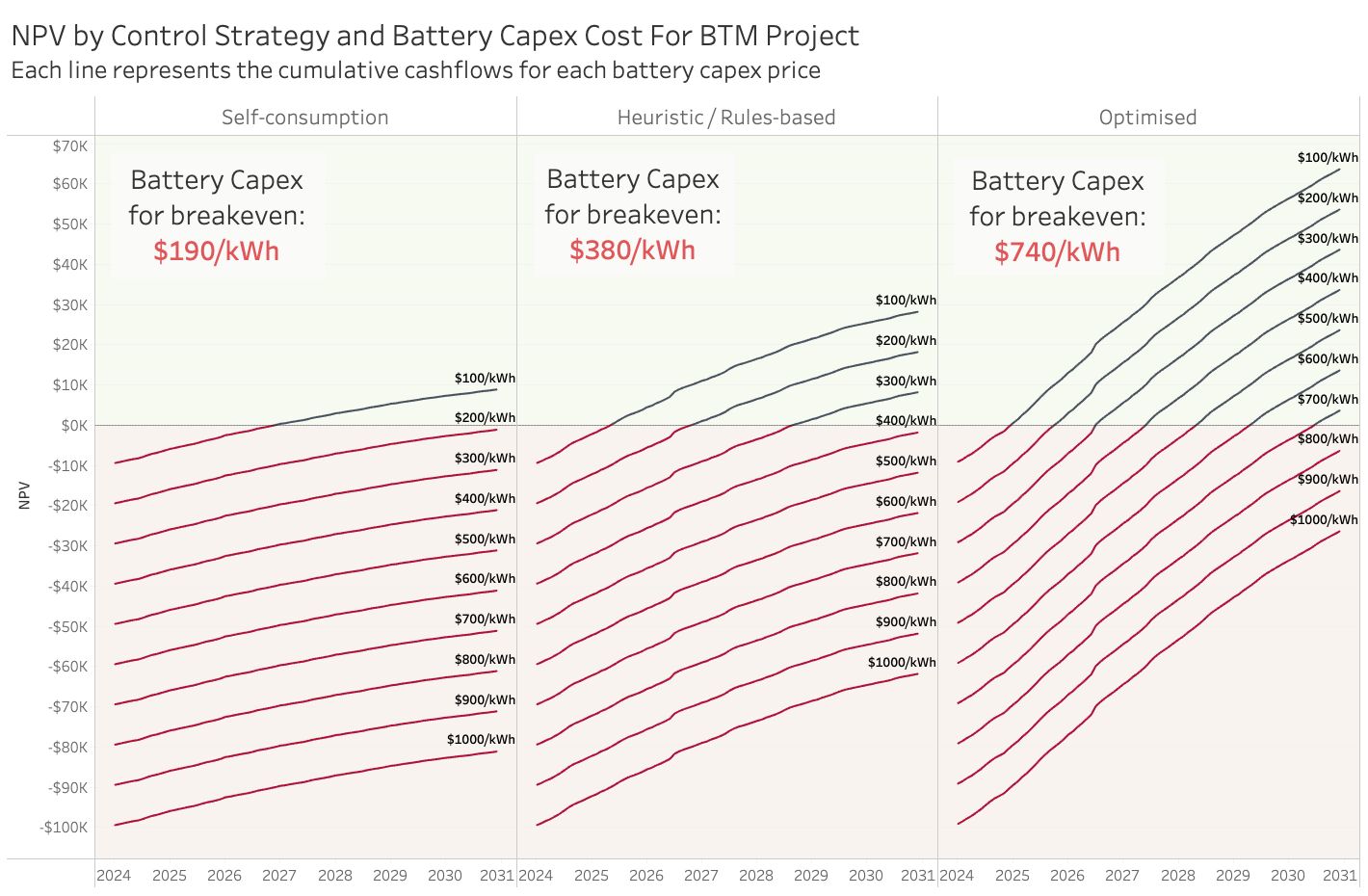Pete Tickler uses Gridcog to test the impact of different battery control strategies by running near-identical versions of the site where the only thing that varies is the way the BESS is controlled.


On 1 October 2021 the National Electricity Market on Australia’s east coast will take the significant step of moving from 30-minute to 5-minute settlement. This will doubtless have lots of interesting ramifications, one of which is likely to be that anyone who is capable of flexing generation or load quickly (in response to short-lived fluctuations in the spot price) will make a dollar (and presumably vice versa to some extent).
The poster child for fast-response generation (or load) is battery storage, which depending on the asset’s state of charge (SOC) at any moment in time, can take advantage of buying or selling opportunities in the market near enough instantaneously. Up until now the 30-minute settlement period hasn’t really allowed assets with very fast response times to shine – it’s a long enough duration that other slower assets can respond – but with the rules changing we thought it would be interesting to take a closer look at what batteries might be able to offer.
To do this we’ve simulated the performance of a range of batteries as though they were chasing wholesale energy arbitrage value in the mainland NEM pricing regions. The assumption is the batteries are either behind-the-meter or are non-scheduled i.e. they’re not bidding into the market themselves. We’ve used 12 months’ worth of spot market data for calendar 2019 and taken the 5-minute dispatch price as our proxy for 5-minute settlement and the 30-minute settlement price to reflect the current market design. Our nominal battery has 1MWh of storage capacity with a range of power outputs (charge and discharge rates) from 0.25MW up to 2MW.
The batteries’ control algorithm relies on perfect foresight – it looks to charge into the lowest prices and discharge into the highest prices each day. Yep, that’s cheating and not how things work in real life, however in this instance we are not trying to model likely earnings but rather to compare performance between the two market designs. The battery does incorporate some characteristics of the real-world in that it’s constrained by its state of charge at any point in time i.e. if it ran flat the previous evening it’s unable to discharge into a high price event the following day until it has first found a low price to charge into.
First up, it’s important to state that the analysis below is for informational purposes only. It’s not investment advice, it’s a fun exercise that demonstrates how changes in market rules might benefit certain types of storage asset.
So, with that said, what did we learn? The heat map below shows the expected arbitrage benefit over 12 months for the different batteries for each NEM region for both the 30-minute and 5-minute markets. There is an increase in value under the 5-minute rule in all markets and for all battery configurations. The benefit is greatest for higher powered batteries in South Australia. High powered because with just 5 minutes in a settlement window the batteries are power limited rather than energy limited. South Australia because in 2019, the year we used for our analysis, they experienced more volatility than other NEM regions.

To get a better sense of exactly how a battery can benefit from 5-minute settlement over and above the current market setup, here’s a play-by-play of one particular day in our simulation. December 9th 2019 in South Australia had a period of significant and short-lived volatility with a number of 5-minute dispatch intervals hitting close to the market floor of -$1000 MWh (presumably it was cool and windy in SA that day). Because the pricing events of December 9th were short-lived the 30-minute settlement price only got as low as around -$73 MWh. The animation below simulates how a 1MWh / 2MW battery (operating with perfect foresight but SOC constrained) might have responded to these price signals and the value it might capture (green trace at the bottom).
As you can see the battery earns 10x the revenue under 5-minute settlement from this single event. That’s impressive. Now I’ve cherry picked this particular day to demonstrate the type of market conditions that may be most favourable to fast-response assets but there are plenty of folks who speculate that an increase in short-duration volatility is exactly what we’re likely to see more of in the coming years.
Whilst this modelling suggests that a 5-minute market may present opportunities for battery storage it’s important to remember that wholesale arbitrage is unlikely to get a battery business case over the line by itself, at least with current hardware pricing. There are other value streams available to batteries that can be equally, if not more lucrative, particularly when they’re co-located with a load behind-the-meter and even more so when they’re co-optimised with other DER assets. For a little more on that this recent post might be of interest.

Pete Tickler uses Gridcog to test the impact of different battery control strategies by running near-identical versions of the site where the only thing that varies is the way the BESS is controlled.


Frequency control is a lucrative source of revenue for battery owners but participation in Regulation services also requires material energy throughput, increasing the degradation of the asset and adding complexity to wholesale trading


Unlock the potential of hybrid solar and battery storage systems with our deep-dive into DC-coupled systems. Learn how they work, their advantages, and how they can increase energy exports and boost project revenues. This detailed guide provides insights into modelling complexities and how Gridcog can help you navigate and compare different solutions for effective decision-making in the clean energy sector
